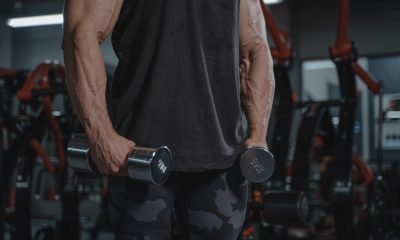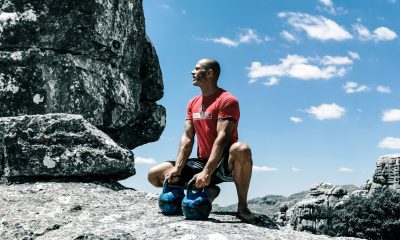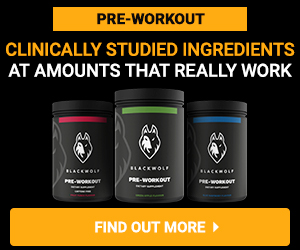Nutrition
Best Creatine Pills vs. Powder – Pros and Cons of Both Forms

Creatine is one common supplement that you can use to achieve several benefits in your body if you are an athlete. It has been in use for a long time and as such, it exists in different forms that have evolved with time throughout its history. Creatine Pills & Powder are one most studied supplements used by athletes and that’s why there is sufficient information on it.
The two common forms that creatine supplement exists are the pills and powder forms. These have often led to problems as people are not sure which form is the best for use. Since both forms exist in practically equal measures, this article highlights some important information on both forms with a stress on the pros and cons of both forms.
Creatine in details
In the body, creatine is a compound, which naturally produced from amino acids. It also acquires from other sources other than the body’s amino acids for example the proteins of animal food. The creatine referred to in this article however is the supplemented form that can be bought from different stores.
Dietary-supplemented creatine that is bought ensures that you get as much creatine as much as possible and not only the minute amounts produced naturally in the body. Used this way, it has an impact on the performance of an athlete and also on the general health of the user. Just like many other dietary supplements, there have risen concerns about their use since it generally interferes with several physiological functions of the body.
Generally, for athletes, creatine is very important in ensuring increased strength, increase muscle mass, and performance as mentioned above. It is the most commonly used supplement because it is among the few supplements that prove to bring about the intended results.
VOLCANO >> HERE
Benefits of using creatine as a supplement
Creatine has a wide range of benefits, some of which we describe here:
1. Creatine increases your energy levels
Creatine has the effect of increasing the available energy. This means that when it comes to your workouts, you will work harder than ever before. Working out harder also leads to muscle hypertrophy. The reason behind the increase in energy is that creatine increases anabolic responses as a result of increased hormones responsible for such activities in the muscle. A good example of such a hormone is insulin-like growth factor-1(IGF-1).
Must Read:: Best Supplements for Energy Levels
2. Reduction of protein breakdown
Creatine has a great impact on reducing the breakdown of proteins in the body. This is advantageous to bodybuilders since it means that they will retain a lot of proteins some of which are a crucial part of the muscles.
3. Hydration
Creatine increases water concentration in muscles. This water is responsible for making your muscles stronger and bigger.
Related Article:: Drink More Water If You Want To Lose Weight And Build Muscle Fast
4. Improving brain function
Aside from muscles and bodybuilding, creatine has been known to improve the functioning of the brain. The supplement when taken leads to increased brain creatine which may improve the function of the brain. The brain functions that have been noticed to improve include short-term memory and reasoning.
5. Growth signaling
Creatine is also important in growth signaling. The growth signals are meant to improve muscle hypertrophy through the action of satellite cells, which are responsible for sending the signals. The signals mainly stimulate muscle repair and growth, particularly after your workouts and training sessions.
6. Reducing the levels of inhibitors
The major inhibitor for muscle growth is myostatin. When it is held back, muscle growth proceeds at a faster rate. Creatine is a very good inhibitor of this compound, and the overall result is an increase in muscle mass at a faster rate.
Besides its use by bodybuilders, creatine has other applications, especially for medical purposes. It has for instance been considered to be helpful in heart diseases, some forms of cancer, muscular dystrophy, and Parkinson's disease among others.
Drawbacks of Creatine
Creatine has been referred to as the safest supplement to be taken. This implies that it has very few if any drawbacks. Many researchers have looked into this area and have concluded the same way. The most important thing that needs the right dosage. As long as one is taking the right dosage, one can be sure to stay safe when using the supplements, unlike other common supplements. There are however a few concerns that a few people have noticed when using creatine. These concerns include:
Cramps and dehydration
A few people who have used creatine supplements have complained of cramps and dehydration. This has not been proved, and there exists no scientific explanation for it. It has actually been shown that creatine actually does the opposite of these health effects.
Bloating
Bloating is perhaps the most reported problem associated with taking creatine supplements. Also, Bloating results in discomfort, especially when one is just beginning to take the supplements, a period called the creatine loading phase. Bloating comes as a result of increased water in the muscles leading to weight gain. The bloating seems to affect only a section of the people who can still avoid it by restricting themselves to a certain amount of the dosage.
Kidney problems
There are no problems that are caused by creatine in the kidney. People have associated creatine with kidney problems because increased creatine also leads to increase creatinine levels and creatinine levels are used as kidney markers. However, this may prove challenging if there already exists a kidney problem. People with such problems are advised not to use creatine before seeking advice from a medical specialist.
Must read:: What Internal Organs can be Affected During Steroid Cycles?
Types of creatine supplements
It comes in different forms, some of which are highlighted here.
Creatine Monohydrate
Creatine monohydrate is the form of creatine that is commonly used in different studies. It is sometimes considered the standard creatine over which all the other forms are compared. It is also the most potent form.
Creatine pyruvate
Creatine pyruvate has a significant effect on increasing the blood levels of creatine. This, however, does not seem to have an influence over the performance.
Creatine citrate
This form is more water-soluble than the others and can help avoid clumping in the water.
Creatine magnesium chelate
When this form of creatine is used as a supplement, it tends to prevent the gain of water, especially at low doses.
MagnaPOWER CREATINE >> HERE
Buffered creatine and creatine hydrochloride
These 2 forms are best known for their conversion back into their basic form by stomach acid.
There are many other forms, including:
- Micronized creatine monohydrate.
- Creatine ethyl ester.
Forms Of Creatine Supplements
Creatine supplements can come in form of pills, powders, or capsules. Capsules contain powder, and therefore there are two major forms in which creatine can acquire, that is, the powder forms and pills forms. Each of these two forms has its own advantages and disadvantages, which are highlighted here below. Generally, people say that they are minor, if any, differences between the two forms. The most important thing to note here is that whether they are pills are powder, the content of creatine is the same. Differences, therefore, come in in other aspects other than the content of creatine taken in.
Creatine Pills
Creatine pills are usually taken together with fluids such as water orally. Taking creatine this way is the best way to increase the creatine levels in your body. Take creatine together with multivitamins without any problems.
THREE-ATINE (Monohydrate) >> HERE
Pros of Creatine Pills
- Transportation - Transportation of pills is much easier instead of powders. This is because they are not likely to spill.
- Less wastage - When taking pills or tablets, you expect little wastage since tablets are not likely to be spilled while being consumed.
- Dosage - When it comes to dosage, pills ensure you get the exact dosage as specified. Pills have that specific amount of monohydrate; hence every pill will be the best for you.
Cons of Creatine Pills
- High Cost - Purchasing pills can be troublesome for some people because they have a higher purchase cost than powder forms of creatine. This will be particularly felt during the loading phase when you need more pills.
- Absorption is slower - Compared to powder, pills have a slow effect after you take them. Attributed to their compact form, which means that they must first be digested before they take the effect on your body. To help minimize the problem, they are taken earlier so they can be absorbed.
- Combining with other supplements is harder - Creatine can be a good companion when combined with complementary supplements. The common supplements which are best combined include carbohydrates and proteins. With pills, however, it might be difficult to combine and only powder form can be useful.
Creatine Powder
Creatine powder is perhaps the most common form of creatine consumed, at least by bodybuilders and other people who like working out.
Micronized Creatine Powder >> HERE
Pros of Powder
- Cost effective - One can easily afford creatine powder as compared to pills.
- Absorbed More Readily - The form of powder as compared to the tablets s readily absorbed because there is no need of digestion.
- Combining with other supplements is easier - Creatine combines more easily with other supplements like mentioned above. The powder form will make it easier to combine unlike their counterparts the pills.
These pros have made many people like the powder as compared to pills. The fact that they are cost effective means that one will spend less on them and also the fact that they can be combined easily with other supplements means that one will get maximum benefits.
Cons of Powder
- Not easy to transport - Spills are common with powdered forms of creatine when transporting and this leads usually to great losses.
- Wastage - Apart from wastage due to transportation problems, powdered creatine is more likely to waste through other forms also. They may for example get stack around the corners of the containers.
- Incorrect dosage - One is more likely to get incorrect dosage when using powdered form of creation as compared to pills. This aspect also closely links to wastage because when the powder sticks on the vessel of taking the powder. Incorrect dosage may even lead to side effects being experience more often.
Related Article:: Top 20 Weight Loss Bodybuilding Supplements to Try This Summer
Effectiveness Of Creatine
Whether in powder or pills form, creatine affects several physiological functions of the body and therefore leading to some effects. How effective creatine can be depends on several goals that one intends to achieve after having used creatine. Here is a clear overview of how effective the supplement can be in the line of what one needs to achieve.
Muscles mass
Creatine has effects on the muscles and several athletes and bodybuilders have been using it to gain muscle mass. With muscle mass, creatine is more effective compared to any other supplement known including the proteins. This will particularly be more pronounced if it is used in during resistance training. All of these arguments are a result of intense training in the area.
CREATINE HMB >> HERE
Strength
You can increase Strength of the muscles through several processes by different supplements. There are those supplements that improve strength through water retention. For creatine however, it has its own way of improving the strength in the muscles. This is through increasing the energy of in the muscles, which means that the muscle cells have the energy needed for their actions. This is much way better than water retention and this makes creatine among the best supplement ever to bring about strength.
Performance
For performance, creatine is good in increasing performance especially when it comes to short burst exercises. It is ability to stimulate production of ATP in sufficient amounts in the muscles is the one responsible for increasing the performance. Creatine does not seem to extend this effectiveness to such activities that require long endurance.
It is very clear that creatine is a perfect supplement that you can count on to help get the best effect ever as seen above. All the information on creatine has been supported by great research and there is therefore no doubt about its effectiveness.
How to take Creatine supplements?
Creatine is an orally taken supplement. Different ages can take in creatine as follows depending on their needs and goals.
Platinum Creatine >> HERE
Children and teenagers
Creatine supplements are not good for children. Sometimes however, they may take them for medical purposes although it is very rare. Requires advice from medical specialist.
Adults
Doses for adults vary from person to person and with the intended effects. For example, the loading dosage requires in exercise performance take 5 g of creatine monohydrate 4 times in a single day for a period of not more than 5 days. One can also take 2 g of the creatine monohydrate each day as part of the maintenance dosage in exercise performance. Something that has been researched and found to be good when taking in creatine is combining it with carbohydrates. The carbohydrate make absorption better.
The Right Time to Take Creatine
Whether you are taking the powder or pills, creatine needs to be taken at the right time. This will depend on which activity you are engaging in during the day. Basically, take creatine during the day when one plans on Exercising.
On the day when you plan to carry out your exercises, you can take creatine in three different way according to how you may like it.
Shortly before exercising
You can take 5g about 30 minutes before you start your exercises. This means that you are going to supply your muscles with creatine instantly and will increase your performance.
Shortly After Exercising
Take creatine Within 30 minutes after your exercises in which you should take just 5g of the creatine. Creatine is good when it comes to muscles recovery therefore people who take creatine after exercises usually have this in mind.
Mornings And Evenings
Take your creatine some few hours before or after the exercise. This is not however justified and may not be good. Using creatine this way produces the least effects as compared to the other two ways. When not on your exercises, you can still supplement your creatine without any bad health effects. This is mainly to ensure that you have high levels of creatine in your muscles all the time. Just ensure that your doses are a little less as compared to when you are going to exercises.
Interactions of Creatine with Other Compounds in the Body
Creatine interacts with several compounds that may also ingeste. These are particularly drugs and therefore when one is taking certain medication, they should be careful not to include creatine as well because it may lead to some unwanted health effects. Some of the drugs that interact with creatine in the body include:
Caffeine
Caffeine interacts with creatine in the body and results may not be good to the user. First, caffeine has the effect of reducing the effect of creatine in the body. It also possess the risk of dehydration. When used together with ephedra, the effect may be disastrous since there is the risk of developing stroke.
Caffeine by nutricos >> BUY IT
Diuretics
Diuretics or what some people call water pills, also interact with creatine leading to harmful effects on the body. Like caffeine, they also lead to dehydration in addition to increasing the chances of kidney damage.
Probenecid
Probenecid is a drug used to treat a condition called gout. It interacts with creatine leading to increased chances of kidney damage.
NSAIDs
Non-steroidal anti-inflammatory drugs interact with creatine and also usually increases the risk of kidney damage. They are some of the most used pain relieving drugs and so one is likely to use them and still use creatine. Great care should therefore take a while.
Creatine Loading
Creatine loading is another good aspect that directly or indirectly relate to whether one uses the creatine powder or pills. It is a phase where one tries to maximize as much as possible the available creatine in their muscles. It basically involves taking in more creatine at the shortest time possible so that the muscles saturate faster.
Necessity Of Creatine Loading Phase
Creatine loading serves to immediately boost your creatine levels at once so that your main task after the phase is to maintain the levels. However, it is not purely necessary that one undergo this phase. This is because even taking smaller doses can eventually bring the levels up and only time makes the difference here.
How Can Creatine Loading Be Beneficial?
Creatine loading is all about maximizing the muscular creatine levels at the shortest time possible and this can be beneficial. Some of the crucial benefits include the following:
- Accelerate Muscle Gain.
- Strength and power also increases up to as much as 5 to 25 %.
- Performance too increases during high intensity exercises.
- Creatine loading is also important in preventing injury such as strains, muscle tightness and other types of injuries common in sporting activities.
Side Effects
 Generally, creatine loading is safe and can be used over both long and short-term periods without many issues. However, it has its own side effects:
Generally, creatine loading is safe and can be used over both long and short-term periods without many issues. However, it has its own side effects:
Gastrointestinal related issues
Gastrointestinal issues are sometimes experienced, but it is very rare for one to experience them. These problems include nausea, vomiting, and diarrhea.
Weight Gain And Bloating
Generally, creatine is associates with weight gain and bloating. With creatine loading, this seems to be accelerated.
Conclusion
Whether you want to use pills or the powder is up to you. It all gets down to what you do every now and then. For example, if you are a person who likes moving from place to place, then you will probably have to settle for pills to avoid losses. Just keep in mind that powders and pills contain the same substance which is equally beneficial and only minor differences come in.
Bodybuilding
Are Nootropics a Better Option to AAS?

Nootropics in bodybuilding refer to supplements or substances that enhance cognitive functions such as focus, memory, motivation, and mental clarity. While traditional bodybuilding supplements focus on muscle growth, strength, and endurance, nootropics target the mental aspect of training. Improved focus and motivation can lead to better workouts, more consistent training, and ultimately better results.
Must Read: A New Caffeine? What You Need to Know about Teacrine
Here are some common nootropics used in bodybuilding:
Caffeine: Widely used for its stimulant effects, caffeine can boost energy, focus, and endurance during workouts.
L-Theanine: Often combined with caffeine, L-Theanine promotes relaxation without drowsiness, helping to balance out the jittery effects of caffeine.
Alpha-GPC: A source of choline that supports the production of acetylcholine, a neurotransmitter essential for cognitive function and muscle contraction.
Rhodiola Rosea: An adaptogen that helps reduce fatigue and improve mental resilience, making it useful for both physical and mental performance.
Bacopa Monnieri: Known for enhancing memory and reducing anxiety, Bacopa is popular for those who want to stay mentally sharp during intense training phases.
Lion’s Mane Mushroom: A natural nootropic that supports brain health, cognitive function, and reduces mental fatigue.
Phenylpiracetam: A racetam-class nootropic that is known for its stimulating effects and ability to enhance focus and mental energy, which can be beneficial during challenging workout sessions.
Stacking Nootropics With AAS
Stacking nootropics with anabolic-androgenic steroids (AAS) in bodybuilding can be an advanced approach to optimizing both physical and mental performance. Here’s a guide on how to combine these substances effectively:
Understanding the Purpose of the Stack
Combining nootropics with AAS aims to enhance not only muscle growth, strength, and recovery (which AAS focus on) but also mental aspects like focus, motivation, and mood (which nootropics address). This stack can help bodybuilders push through plateaus, manage training stress, and maintain peak performance.
Common Nootropics to Stack with AAS
Caffeine + L-Theanine: Enhances alertness and focus while reducing anxiety. Helps with energy and focus during intense workouts.
Alpha-GPC: Boosts acetylcholine levels, improving mental clarity and enhancing the mind-muscle connection.
Rhodiola Rosea: Mitigates stress and fatigue, which is crucial during heavy steroid cycles where physical and mental stress is higher.
Lion’s Mane Mushroom: Promotes cognitive health and neuroprotection, helping you stay sharp during longer cycles.
Bacopa Monnieri: Reduces anxiety and improves memory, supporting better recovery and relaxation outside the gym.
Tips for Stacking
Start with Lower Doses: If you’re new to either nootropics or AAS, start with minimal doses and gradually adjust based on how your body responds. Stacking too much too soon increases the risk of side effects.
Cycle Both Nootropics and AAS: Just like AAS, it’s wise to cycle nootropics to avoid tolerance buildup. For instance, you might use nootropics for 6-8 weeks and then take a break, aligning this cycle with your AAS cycle.
Prioritize Liver and Organ Health: Both nootropics and AAS can stress the liver and other organs. Incorporate liver support supplements like milk thistle, NAC (N-Acetyl Cysteine), and TUDCA (Tauroursodeoxycholic Acid).
Stay Hydrated and Maintain Proper Nutrition: Both nootropics and AAS can increase metabolic demands. Staying hydrated and following a nutrient-rich diet ensures better overall performance and health.
Related Article: Protein Powder Supplement Comparison – Which Type To Choose?
Sample Stack for a Cutting Phase
Nootropics: Caffeine + L-Theanine, Alpha-GPC, Rhodiola Rosea
AAS: Testosterone Propionate, Trenbolone Acetate, Anavar (Oxandrolone)
Support Supplements: Liver support (NAC, TUDCA), multivitamins, omega-3s
This stack can help maintain muscle mass, enhance focus and energy during workouts, and support mental well-being during calorie deficits.
Sample Stack for a Bulking Phase
Nootropics: Lion’s Mane, Bacopa Monnieri, Alpha-GPC
AAS: Testosterone Enanthate, Deca-Durabolin (Nandrolone Decanoate), Dianabol (Methandrostenolone)
Support Supplements: Joint support (collagen, glucosamine), digestive enzymes, liver support
This combination can boost cognitive function, improve recovery, and support the intense training needed for mass-building phases.
Stacking nootropics with AAS can offer significant benefits for bodybuilders aiming for peak mental and physical performance. However, it’s critical to approach this strategy with caution, considering the possible interactions and side effects. Always consult a healthcare professional before starting any stack, especially one involving AAS and nootropics.
Possible Side Effects Associated With Nootropics
While nootropics can enhance cognitive function, focus, and motivation, they can also cause side effects, especially when used in high doses or stacked with other supplements like anabolic-androgenic steroids (AAS). Some common side effects associated with nootropics in bodybuilding include:
1. Insomnia and Sleep Disturbances
Many nootropics, especially stimulants like caffeine, can lead to difficulties falling asleep or maintaining restful sleep. This is particularly problematic if taken late in the day, as sleep is critical for recovery and muscle growth.
2. Anxiety and Nervousness
Nootropics that stimulate the central nervous system (e.g., caffeine, phenylpiracetam) can increase anxiety, jitteriness, or nervousness, especially when combined with other stimulants or during periods of high stress.
3. Headaches
Certain nootropics, particularly racetams (like piracetam or aniracetam), can deplete choline levels in the brain, leading to headaches. Supplementing with choline sources like Alpha-GPC can help mitigate this side effect.
4. Gastrointestinal Issues
Some nootropics may cause nausea, stomach cramps, or diarrhea, especially if taken on an empty stomach or in high doses.
5. Mood Swings and Irritability
Nootropics that affect neurotransmitter levels (like dopamine or serotonin) can lead to mood swings, irritability, or even depressive symptoms if used improperly or if taken in combination with AAS, which can already impact mood.
6. Tolerance and Dependence
Frequent use of certain nootropics, particularly stimulants, can lead to tolerance, where increasing doses are needed to achieve the same effect. This can also result in dependence, where users feel they need the nootropic to function optimally.
7. Overstimulation
High doses or the wrong combination of nootropics can cause overstimulation, leading to symptoms like rapid heart rate, high blood pressure, and excessive sweating. This can be particularly risky during intense workouts.
8. Cognitive Fatigue or Brain Fog
In some cases, nootropics intended to boost focus or clarity can backfire, leading to cognitive fatigue or brain fog. This can happen due to overloading neurotransmitter pathways or poor dosing strategies.
9. Interactions with Other Supplements or Medications
Nootropics may interact with other bodybuilding supplements, medications, or AAS, leading to unexpected side effects. For example, combining stimulants like caffeine with pre-workouts or fat burners can amplify side effects like anxiety or heart palpitations.
10. Long-Term Safety Concerns
The long-term effects of many nootropics are not well-studied, especially when taken in high doses or combined with other substances. Chronic use could potentially lead to neurological imbalances or organ stress over time.
Mitigating Risks
Start Low and Go Slow: Begin with low doses and gradually increase to assess your tolerance.
Cycle Usage: Avoid using the same nootropics daily to prevent tolerance and dependence.
Stay Hydrated and Eat Well: Proper hydration and nutrition can reduce the risk of gastrointestinal and cognitive issues.
Monitor Your Response: Keep track of how you feel when taking nootropics and adjust accordingly if you notice negative side effects.
Consult a Professional: If you’re stacking nootropics with other substances like AAS, it’s essential to get medical advice to avoid harmful interactions.
While nootropics can offer cognitive and motivational benefits in bodybuilding, responsible use and monitoring are key to minimizing side effects.
Take Away
To conclude, nootropics can help bodybuilders maintain high levels of mental energy, motivation, and focus during training, which is essential for pushing through tough workouts and staying consistent with your fitness goals. However, as with any supplement, it’s important to research and consider potential side effects and interactions.
Don't Miss: Horse Chestnut and Other Supplements to Get Rid of Water Retention
Bodybuilding
How Effective is Bone Broth for Recovery?
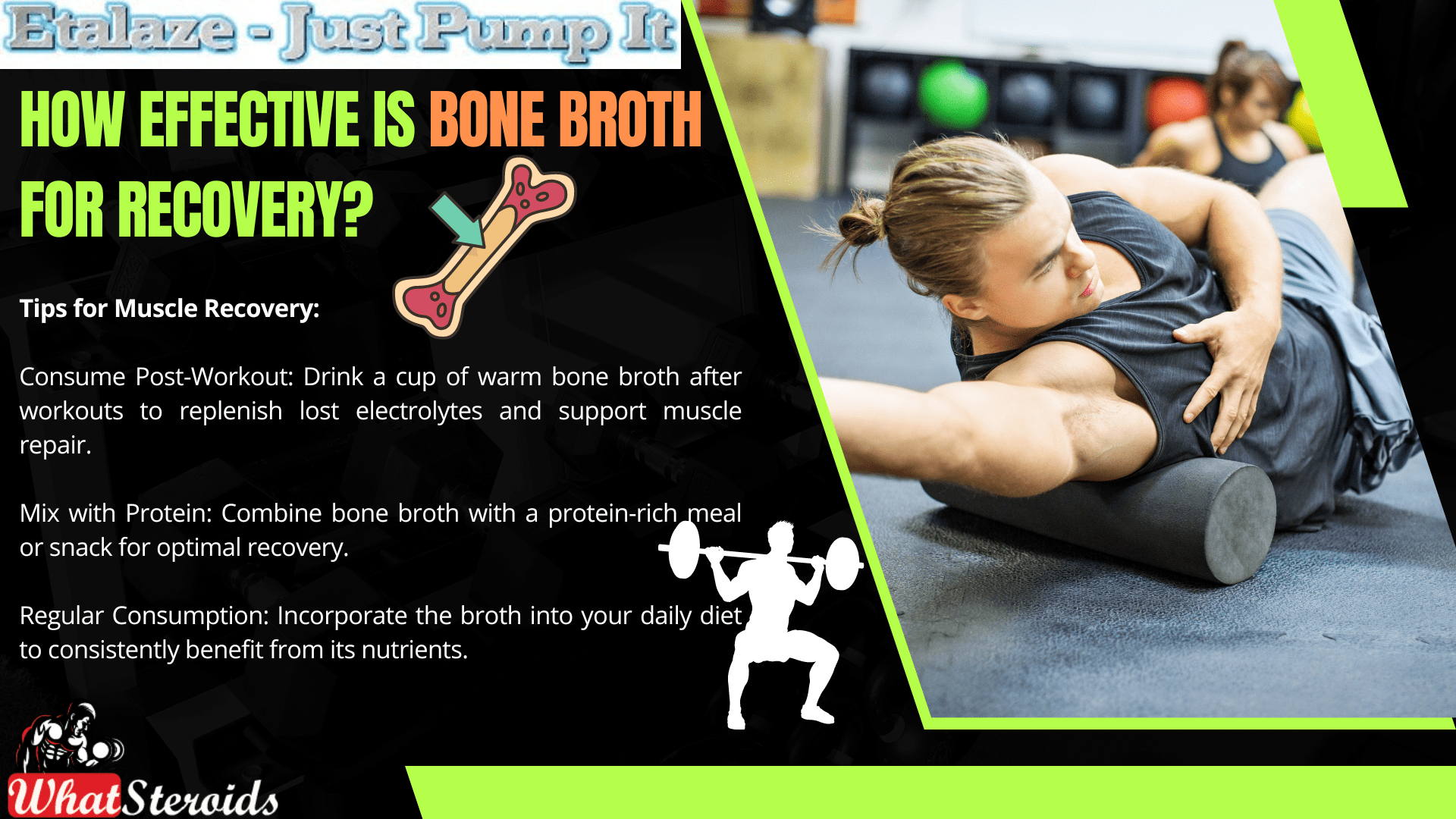
Bone broth has gained popularity in the fitness community, including among bodybuilders, due to its potential benefits for recovery. It is a nutrient-dense liquid made by simmering animal bones and connective tissues for an extended period. This process extracts a variety of beneficial compounds and nutrients. Here's how it is effective for post-workout recovery:
1. Bone Broth is Rich in Collagen and Gelatin:
Bone broth is high in collagen, a protein that supports joint, tendon, and ligament health. Gelatin, derived from collagen, may help reduce joint pain and inflammation, which is beneficial after intense workouts.
2. Amino Acid Profile:
Bone broth contains important amino acids like glycine, proline, and glutamine. These amino acids support muscle repair and growth, immune function, and gut health—all crucial for recovery.
3. Electrolytes and Hydration:
It provides electrolytes like potassium, magnesium, and calcium, which help with hydration and muscle function. Proper hydration is key to recovery and preventing cramps or muscle fatigue.
4. Mineral Content:
Bone broth is rich in essential minerals like calcium, phosphorus, and magnesium. These minerals contribute to bone health and muscle contraction, supporting recovery.
5. Anti-Inflammatory Properties:
The nutrients in the broth may help reduce inflammation, speeding up recovery and reducing soreness after workouts.
6. Supports Gut Health:
Bone broth can help heal and maintain the gut lining, which is important for nutrient absorption and overall recovery.
Must Read: Best supplements for College students
How to Prepare Bone Broth at Home
Preparing bone broth at home is straightforward and can be customized to fit your dietary needs for muscle recovery. Here’s a step-by-step guide:
Ingredients:
- Bones: Use a mix of beef, chicken, pork, or fish bones. Marrow bones, knuckles, and joints are especially rich in collagen.
- Vegetables (optional): Carrots, celery, onions, and garlic add flavor and nutrients.
- Vinegar: 1-2 tablespoons of apple cider vinegar help draw out minerals from the bones.
- Herbs and Spices (optional): Bay leaves, thyme, rosemary, and peppercorns for added flavor.
- Water: Enough to cover the bones and vegetables.
Instructions to Prepare Bone Broth
- Prepare the Bones:
- Roasting (optional but recommended): Roast the bones in the oven at 400°F (200°C) for 30-40 minutes. This enhances the flavor of the broth.
- Place Bones in a Pot:
- Transfer the bones to a large stockpot, slow cooker, or pressure cooker.
- Add Vegetables and Vinegar:
- Add your chosen vegetables and the apple cider vinegar to the pot. Vinegar is crucial as it helps extract the minerals from the bones.
- Cover with Water:
- Add enough water to cover the bones by about 2 inches. Avoid adding too much water, as it can dilute the broth.
- Cooking Time:
- Stovetop: Bring the water to a boil, then reduce the heat to a simmer. Cook for 12-24 hours. The longer you simmer, the more nutrients you extract.
- Slow Cooker: Set on low and cook for 12-24 hours.
- Pressure Cooker: Cook on high pressure for 3-4 hours.
- Skim the Foam:
- During the first hour of cooking, you might notice some foam rising to the top. Skim it off with a spoon to keep the broth clear.
- Add Herbs and Spices (optional):
- In the last hour of cooking, add any herbs or spices for flavor.
- Strain the Broth:
- Once the broth is done, strain it through a fine-mesh sieve or cheesecloth into another pot or large container to remove the bones and vegetables.
- Cool and Store:
- Let the broth cool. You can refrigerate it for up to 5 days or freeze it in portions for longer storage.
- Use the Broth:
- You can drink the broth as-is, use it as a base for soups or stews, or incorporate it into your post-workout meals.
Tips for Muscle Recovery:
Consume Post-Workout: Drink a cup of warm bone broth after workouts to replenish lost electrolytes and support muscle repair.
Mix with Protein: Combine bone broth with a protein-rich meal or snack for optimal recovery.
Regular Consumption: Incorporate the broth into your daily diet to consistently benefit from its nutrients.
Making the broth at home allows you to control the ingredients and flavor, ensuring a nutrient-rich recovery drink tailored to your needs.
Don't Miss: Chia Seeds in A Bodybuilder’s Diet: An Expert’s Advice
Incorporating Bone Broth In Your Diet
Incorporating bone broth into your bodybuilding diet can be both delicious and beneficial. Here are some creative ways to include it:
- Post-Workout Drink: Simply heat up a cup of bone broth and drink it after your workout. It’s a great way to replenish electrolytes and protein.
- Smoothies: Add a scoop of bone broth protein powder to your post-workout smoothie. It blends well with fruits and other ingredients.
- Soups and Stews: Use bone broth as a base for soups and stews. It’s an excellent way to add flavor and nutrients to your meals.
- Cooking Grains: Cook your rice, quinoa, or other grains in the broth instead of water. This enhances the flavor and nutritional content.
- Sauces and Gravies: Incorporate bone broth into sauces and gravies for added depth of flavor and health benefits.
- Marinades: Use bone broth as a base for marinades for meats and vegetables. It adds a rich flavor and helps tenderize the meat.
- Bone Broth Ice Cubes: Freeze bone broth in ice cube trays and add the cubes to your dishes as needed. This is a convenient way to add a nutritional boost to any meal.
- Bone Broth Tea: Mix bone broth with herbs and spices to create a savory tea. This can be a soothing and nutritious drink.
These methods can help you enjoy the benefits of bone broth while keeping your diet varied and interesting. Have you tried any of these methods before?
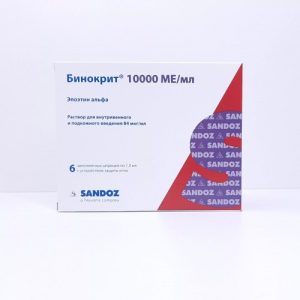 Click Here to Buy Binocrit EPO 10 000IU (6 pre-filled pens) by Sandoz
Click Here to Buy Binocrit EPO 10 000IU (6 pre-filled pens) by Sandoz
Which Animal's Bones Give the Best Broth?
Different animal bones can be used to make broth, each offering unique benefits for bodybuilding recovery. Here are some of the best options:
Beef Bones: Beef bones, especially marrow bones, knuckles, and joints, are rich in collagen and gelatin, which support joint health and muscle recovery. They also provide a deep, rich flavor and are packed with minerals like calcium and magnesium.
Chicken Bones: Chicken bones, particularly those from the feet and wings, are high in collagen and gelatin. Chicken broth is lighter in flavor but still rich in nutrients that aid in muscle repair and joint health.
Fish Bones: Fish bones, especially from oily fish like salmon, are excellent for a lighter broth that is rich in omega-3 fatty acids. These fatty acids have anti-inflammatory properties, which can help reduce muscle soreness and promote recovery.
Pork Bones: Pork bones, including the feet and hocks, are also good sources of collagen and gelatin. They produce a flavorful broth that can support joint and muscle health.
Lamb Bones: Lamb bones are another great option, providing a rich, flavorful broth that is high in collagen and minerals.
Each type of bone broth has its own unique flavor and nutritional profile, so you might want to try different ones to see which you prefer and which best supports your recovery needs.
Related Article: Essential Techniques to Master Squats Form
Overall
Can I use bone broth while on steroids? Yes, bone broth can be beneficial for bodybuilders who are using steroids or other supplements, as it provides essential nutrients that support overall health and recovery. Steroids and other performance-enhancing drugs often place additional stress on the body, particularly on the liver, kidneys, joints, and connective tissues. As mentioned, bone broth is rich in collagen, gelatin, amino acids like glycine and proline, and minerals such as calcium and magnesium, which help support joint health, reduce inflammation, and promote gut health. These benefits are especially important for bodybuilders using steroids, as these drugs can sometimes exacerbate joint pain, weaken connective tissues, or cause digestive issues.
Additionally, bone broth can help with hydration and provide electrolytes, supporting muscle function and recovery. While it shouldn't replace other key nutrients and should be used alongside a well-rounded diet and supplement regimen, bone broth can serve as a natural, nutrient-dense addition that helps mitigate some of the side effects of steroid use and enhances overall recovery and performance.
Bodybuilding
Calorie Dumping: A Bodybuilder’s Guide

"Calorie dumping" in bodybuilding refers to a strategy where an individual consumes a large number of calories in a single meal, often following a period of low-calorie intake.
This practice is believed to support muscle growth by providing a surplus of energy and nutrients.
The idea is that after a period of restricted calorie intake, the body becomes more efficient at utilizing nutrients, making it more receptive to absorbing and utilizing the surplus calories in a short period.
However, this approach may not suit everyone and should be approached cautiously as it can lead to discomfort and potential digestive issues.
Calorie dumping, also known as refeeding or cycling calories, is sometimes preferred by bodybuilders to help prevent metabolic adaptation and aid in breaking through plateaus.
By occasionally consuming higher calorie levels, they aim to boost metabolism, replenish glycogen stores, and maintain hormone balance for better muscle growth and fat loss in the long term.
Bodybuilders focus on controlled nutrition plans to optimize muscle growth and minimize fat gain. However, occasionally, you might increase the calorie intake temporarily before an intense workout or competition to boost energy levels, but this isn't considered calorie dumping in the traditional sense.
ALSO READ: Your Guide to Become A Successful Personal Trainer
Long-term and Short-term Benefits of Calorie Dumping
Short-term benefits include replenishing glycogen stores, boosting metabolism, and providing mental relief from a strict diet.
Also known as a "refeed" or "cheat day," bodybuilders do calorie dumping for several long-term reasons:
Best Foods for Calorie Dumping
-

 Steroids2 years ago
Steroids2 years agoVOX Testing: Why Bodybuilders Must Have It Tested Regularly
-

 Steroids2 years ago
Steroids2 years agoShavers and Other Body Grooming Equipment for Bodybuilders In 2023
-

 Steroids2 years ago
Steroids2 years agoChatGPT and Other Avenues to Find Great Bodybuilding Coaches
-

 Steroids2 years ago
Steroids2 years agoBest Oil Recommendations Before Competition for Subtle Shimmer
-

 Steroids2 years ago
Steroids2 years agoPowerlifting Vs Power Building: Find Out the Big Difference and When to Shift Between the Two
-

 Anabolic Steroids1 year ago
Anabolic Steroids1 year agoLegality of Anabolic Steroids In Latin America
-

 Nutrition1 year ago
Nutrition1 year agoEverything Nutritional Food: What’s Too Much Or Too Little
-

 Bodybuilding Products12 months ago
Bodybuilding Products12 months agoTelmisartan In Bodybuilding: An Expert’s Advice
-

 Beginners2 years ago
Beginners2 years agoTren Cycle for Beginners
-

 Bodybuilding1 year ago
Bodybuilding1 year agoList of FDA-Approved Peptides
-

 Bodybuilding2 years ago
Bodybuilding2 years agoCompetition Prep Cycle for Pro Bodybuilders
-

 Anabolic Steroids10 months ago
Anabolic Steroids10 months agoHow Much Do You Know About B-AET? A Fat Burner You’ve Been Missing
-

 Bodybuilding1 year ago
Bodybuilding1 year agoChia Seeds in A Bodybuilder’s Diet: An Expert’s Advice
-

 Steroids11 months ago
Steroids11 months agoAnadrol Cycle: Benefits, Doses, Alternatives, etc.
-

 Bodybuilding7 months ago
Bodybuilding7 months agoPrimal Movements: Our Ultimate Guide for Maximum Results
-

 Anabolic Steroids8 months ago
Anabolic Steroids8 months agoJoint Stiffness: How to Manage It While on AAS
-

 Product Reviews10 months ago
Product Reviews10 months agoTop Vitamins for Skin Health
-

 Steroids9 months ago
Steroids9 months agoOmnitope (Oxytocin)
-

 Bodybuilding1 year ago
Bodybuilding1 year agoHow Much Is Too Much Cardio? Understanding Heart Rate Zones
-

 Steroids10 months ago
Steroids10 months agoMajor Bodybuilding Peptides Explained
-

 Bodybuilding9 months ago
Bodybuilding9 months agoHormone Replacement Therapy (TRT) Cycle Guide
-

 Bodybuilding8 months ago
Bodybuilding8 months agoHow Effective is Bone Broth for Recovery?
-

 Anabolic Steroids1 year ago
Anabolic Steroids1 year agoStart The New Year Strong With These Tips
-

 Steroids1 year ago
Steroids1 year agoTrenbolone: Why it Remains A Beast In the Market
-

 Bodybuilding10 months ago
Bodybuilding10 months agoHere Is How To know Your MRV (Maximum Recoverable Volume)








